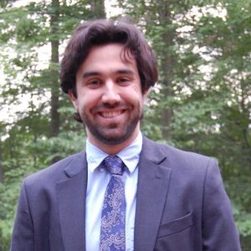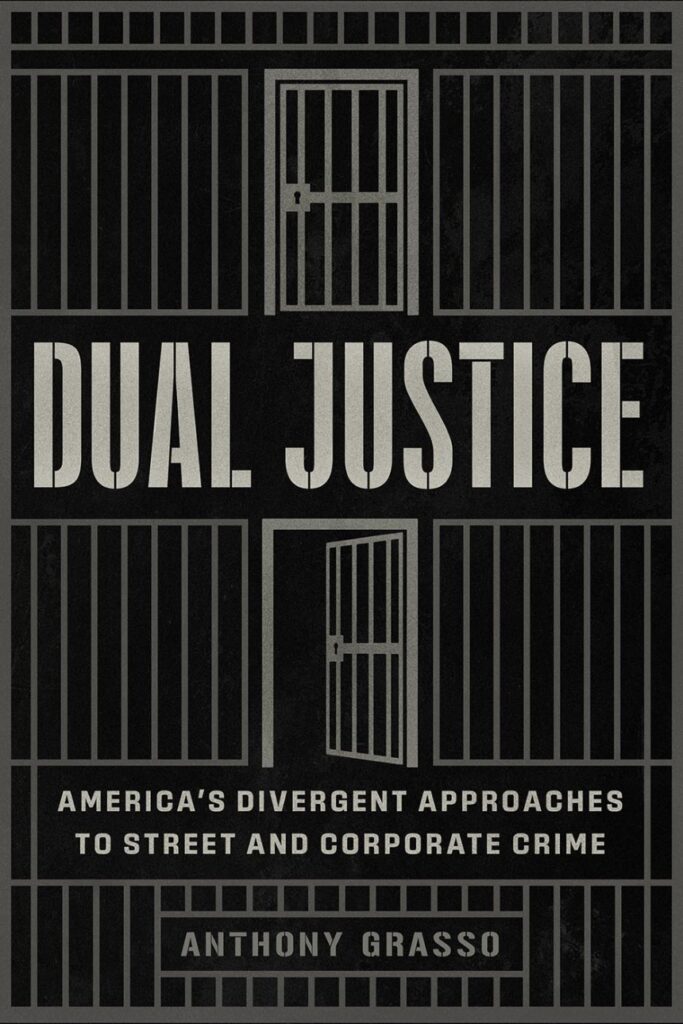America has a dual justice system – one for corporate crime and one for street crime.
We hit street crime with punitive measures. And corporate crime with more lenient regulatory controls.
How did this come about?
Anthony Grasso wanted to know. In graduate school, he wrote a dissertation that explored the reasons. And that dissertation became his first book – Dual Justice: America’s Divergent Approaches to Street and Corporate Crime (University of Chicago Press, 2024).
While America incarcerates its most marginalized citizens at an unparalleled rate, the nation has never developed the capacity to consistently prosecute corporate wrongdoing.
Dual Justice unearths the intertwined histories of these two phenomena.
By examining the carceral and regulatory states’ evolutions from 1870 through today, Grasso shows that America’s divergent approaches to street and corporate crime share common, self-reinforcing origins.
During the Progressive Era, scholars and lawmakers championed naturalized theories of human difference to justify instituting punitive measures for poor offenders and regulatory controls for corporate lawbreakers.
These ideas laid the foundation for dual justice systems: criminal justice institutions harshly governing street crime and regulatory institutions governing corporate misconduct.
Since then, criminal justice and regulatory institutions have developed in tandem to reinforce politically constructed understandings about who counts as a criminal.
Grasso is an assistant professor of political science at Rutgers University in Camden, New Jersey.
What are the divergent approaches to street and corporate crime?
“The book argues that American institutions adopt two separate approaches to street crime and corporate crime,” Grasso told Corporate Crime Reporter in an interview last month. “The core argument is that the criminal justice system is designed to govern street crime very punitively. The second justice system is the regulatory state. And that is designed to govern corporate crime through the operations of regulatory agencies and bodies.”
“And they have all sorts of discretion to respond to and govern behavior we deem illegal and often in law through all sorts of administrative interventions, civil lawsuits, equity law.”
“So it’s essentially two justice systems – the criminal justice system to punish street crime punitively and the regulatory system to punish corporate crime in a very different way.”
Most academics in this area are studying street crime. A handful are studying corporate crime. A few, like John Braithwaite, look at both. Who are the others who are maybe your predecessors in your analysis?
“One book that inspired me was John Hagan’s book Who Are the Criminals?: The Politics of Crime Policy from the Age of Roosevelt to the Age of Reagan (Princeton University Press, 2012),” Grasso said. “He has a similar perspective. He looks from the New Deal era onward. He reached some similar conclusions.”
“There is a book by Bernard Harcourt called The Illusion of Free Markets: Punishment and the Myth of Natural Order (Harvard University Press, 2011). He looks at broader trends in political theory to try and explain why we govern white-collar crime more leniently and through economic approaches as opposed to the very harsh approach we take to the criminal justice system.”
“And there are academics in criminology who have looked at this. Jeffrey Reiman and his colleagues wrote The Rich Get Richer and the Poor Get Prison (Pearson). They argue that the criminal justice system is designed to fail, to drive our fear of street crime instead of against corporate crime.”
“So yes, there are people who have taken this point of view. What makes my approach different is not just the timeline I use, but also my argument is that our approach to street crime and corporate crime have shared roots in these eugenic ideas that say – this kind of person is pathologically flawed and this kind of person is naturally superior. We have to govern their harmful behavior differently.”
Why would people conclude that if you are with a corporation you are a better person than if you are not?
“When I started researching this book, I did not expect to find much in the eugenics literature on corporate crime. I really didn’t. I dove into those older eugenics books and was expecting to find the Lombroso influence – these minority offenders, they are pathologically criminal, we have to lock them up. They are incorrigible. We can’t save them. They are born to crime. I was totally expecting that.”
“I did not expect to find corporate crime in the eugenics literature. But many of these eugenicists were saying – these leaders of these major corporations – these guys are providing some kind of social good, they are producing major profits. The end result is that they are doing something economically desirable. And the conclusion was – if they engage in something that looks like crime, it can’t be a function of their inherently criminal disposition.”
“They don’t look like the street criminal. They look different. Their actions look different. Therefore, their crimes must be some offshoot of their entrepreneurial spirit, which was contextualized by eugenicists as something you were born with.”
“I think of G. Frank Lydston writing in 1904. He has this whole chapter where he says – look at these poor people. He calls them tramps. Look at these tramps. They are born criminals. Their skulls have the exact same deformities. Sloped foreheads, large ears. That makes them inferior to the general population.”
“And then in the next chapter, he addresses the robber barons, the corporate criminals of the time. And he says – they don’t look anything like these street criminals. They look totally different. So it can’t be the same criminal nature driving the petty thief. It has to be something else. It’s the natural competitive vigor and drive.”
“And lawmakers of the time were very much echoing these eugenicist ideas and saying – to street criminals, we have to respond punitively. But those robber barons don’t look anything like them. They are producing some sort of social good. Their harms must be unavoidable secondary effects of their entrepreneurial spirits. It’s like a misguided cousin of the entrepreneurial spirit.”
There were white street criminals that looked like the robber barons.
“Eugenics was very much wrapped up in racial questions. There was the idea that people of color and immigrants were inherently defective, that they had evolutionarily defective genes that rendered them inferior to everyone else and that’s what made them criminal. It was very much based on racial appearance variables.”
“But I also think there was a major class component wrapped up in eugenics. Poverty was also very much understood as indicative of a criminal disposition. Eugenicists looked at racial inequality, class inequality, poverty and criminality and said all of these things look very much like they are consequences of this singularly flawed biological disposition.”
“So as to your question about some of the street criminals looking like robber barons – yes, some were white men who might have looked the same. Why were they stigmatized by the eugenicists? Because of their class status. That was equated with a criminal disposition, as was race.”
“It’s garbage science. But that was the idea.”
Are you suggesting that we flip the script? Because these corporate crimes are more damaging to society, we should treat them with more punitive measures and treat street criminals with a more lenient approach?
“I do think we need a much stronger approach when it comes to prosecuting corporate crime. I reference the work of John Braithwaite and Ian Ayres. And their basic argument is that regulation only works if regulators and the state are willing to resort to the big gun of prosecution when things get really bad. If the state is not willing to prosecute corporate crime, then why bother following these minor technical regulations?”
“I do think there needs to be a much more sustained and stronger commitment to prosecuting corporate crime when things get really bad and when necessary.”
“But I also advocate that we proceed with caution. I don’t know that making the criminal justice system so much bigger to handle corporate crime is a safe solution. We can imagine vastly expanding the criminal justice system to lock up all of these law breaking corporate executives, and then a new administration comes in and says – we have this giant new set of institutions, let’s just weaponize them against the poor.”
“I’m a little cautious about expanding those institutions too much. We should definitely make more use of prosecution of corporate crime, but we also have to look at expanding the regulatory approach and apply it to street crime as well.”
“We use the regulatory state to lightly monitor corporate wrongdoing, to check the imperfections and problematic incentives of the political economy so that corporate executives don’t engage in wrongdoing, we try to regulate the structure of the political economy to prevent criminal conditions from growing. We need to take that logic and apply it to street crime. How can we regulate economic structures in poor communities without punitive interventions?”
[For the complete q/a format Interview with 38 Corporate Crime Reporter 46(12), November 25, 2024, print edition only.]

